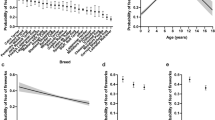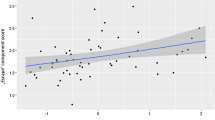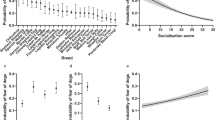Abstract
In Fukushima, Japan, a prolonged refugee situation caused by a major nuclear incident after the earthquake of March 11, 2011 has led to the unintentional abandonment of many pets. We received stray or abandoned dogs from rescue centers in Fukushima Prefecture. During re-socialization training and health care, we accessed the behavioral characteristics and the urine cortisol level of each dog and compared them with those of other abandoned dogs not involved in this earthquake. The dogs from Fukushima showed significantly lower aggression toward unfamiliar people, trainability and attachment to their caretakers; also, urine cortisol levels in the dogs from Fukushima were 5–10-fold higher than those in abandoned dogs from another area of Japan. These results suggested that the dogs from Fukushima suffered through an extremely stressful crisis.
Similar content being viewed by others
Introduction
Japan will never forget the earthquake of March 11, 2011. Center offshore of Miyagi Prefecture, the earthquake devastated the Tohoku coastline and caused a major nuclear incident. Around 340,000 people still live as refugees1 and may have incurred psychological damage from continued fear of aftershocks and radiation contamination, the loss of their hometowns and the collapse of their communities. Posttraumatic stress disorder (PTSD) is feared to pose a serious health risk to those people2. The earthquake also affected companion animals that were living as pets in the disaster area. In Fukushima Prefecture, the prolonged refugee situation has led to the unintentional abandonment of many pets. Many dogs have roamed or been chained and left alone for long periods and some of them have been living in a semi-feral state in the exclusion zone around the nuclear reactor. Students at Azabu University have conducted a program for placement of abandoned dogs from a Kanagawa rescue center with new owners after provision of psychosomatic care in a training facility at the University. In 2011, we provided these services for disaster-affected dogs from Fukushima. These dogs have been forced to experience not only unusual living environments but also unexpected separation from their family members. This would make a great impact on dogs because the companionship of family members is indispensable for dogs to maintain normal behavioral and endocrine stress responses3. In human studies, chronic stress has been shown to induce psychological disorders and dysregulation of stress neuroendocrinological systems4,5. We expected that the Fukushima dogs might be under chronic stress and show behavioral and neuroendocrine stress responses that may possibly be attributable to the above-mentioned unusual living environments. Therefore, in order to elucidate the impacts of stress from one of the highest magnitude earthquakes recorded in history, we compared behavior and urinary cortisol levels between disaster-affected dogs and non-disaster-affected abandoned dogs.
Results
Regarding the Canine Behavioral Assessment and Research Questionnaire (C-BARQ)6, we conducted a multiple linear regression analysis by using sex, place where the dogs came from (Fukushima and Kanagawa; “the place”), age and time of assessment (the first and third month after transportation from the facilities; “the timing”) as predictor variables. The results revealed that the significantly related variable was only “the place” in the below-mentioned five items: aggression toward unfamiliar people (R2 = 0.191, p = 0.001, β = −0.456, p = 0.001), aggression toward unfamiliar dogs (R2 = 0.154, p = 0.003, β = −0.414, p = 0.003), separation anxiety (R2 = 0.179, p = 0.001, β = −0.443, p = 0.001), trainability (R2 = 0.115, p = 0.018, β = −0.339, p = 0.018) and attachment (R2 = 0.288, p < 0.001, β = −0.550, p < 0.001). A comparison between Fukushima dogs and Kanagawa dogs revealed that the Fukushima dogs showed significantly lower aggression toward unfamiliar people (U = 31.0, p = 0.03), trainability (U = 35.5, p = 0.04) and attachment (U = 16.0, p = 0.01) when evaluated one month after transportation from the facilities. In the assessment of 3 months after the transportation, Fukushima dogs showed significantly lower separation anxiety (U = 30.0, p = 0.03) and attachment (U = 30.5, p = 0.04; Fig. 1). We also conducted a multiple linear regression analysis by using sex, place, age and the day of urine collection (days 1–14, 21, 28, 35, 42, 49, 56, 63, 70 after the transportation: “the day”) as predictor variables. We found that the place and the day were significantly related to cortisol levels (R2 = 0.478, p < 0.001; the place: β = 0.653, p < 0.001; the day: β = −0.164, p < 0.001). To compare these factors, the two-way mixed model was used with the factors the place and the day and the place showed a significant effect (F = 50.168, p < 0.001). Cortisol levels in the dogs from Fukushima were 5–10-fold higher than those in the dogs from Kanagawa (p < 0.001) and this trend persisted even after 10 weeks. Each one-way mixed model revealed that the Fukushima dogs showed markedly high urine cortisol levels in the first week after arrival (F = 3.34, p < 0.01, Fig. 2-A, B). In contrast, the urine cortisol levels of the Kanagawa dogs did not show any statistically significant changes over time (F = 1.45, p = 0.10, Fig. 2-A, C). Breed difference was not observed in both C-BARQ scores and cortisol levels (see supplementary information).
Median scores for C-BARQ behavioral evaluation criteria at 1 month and 3 month after arrival.
During the first month, there were significant differences in aggression toward unfamiliar people (p = 0.03), trainability (p = 0.04) and attachment (p = 0.01) between the Fukushima dogs and the Kanagawa dogs. The Fukushima dogs showed significant lower attachment (p = 0.04) than the Kanagawa dogs until the third month.
Urine cortisol levels over a 10-week period after arrival.
A. The levels were significantly higher in dogs from Fukushima than in those from Kanagawa. Fukushima dogs' urinary cortisol levels were highest on the day of arrival and declined significantly after the 8th day, while the Kanagawa dogs showed no significant changes in urine cortisol levels over time. Values are mean ±s.e.m. B, C. Scatterplots of individual urine cortisone levels.
Discussion
The endocrine responses of the Fukushima dogs suggested extreme stress, which persisted even after 10 weeks of adequate care. Dogs with more-aggressive behavior, especially social conflict-related aggression directed towards family members, show higher cortisol levels compared with non-aggressive dogs7. However, the dogs in this study showed lower levels of aggression together with higher cortisol levels, suggesting that stress symptoms did not directly manifest in their aggressive behavior. Moreover, dogs introduced to shelters usually show elevated cortisol levels for the first three days, followed by a comparatively fast decline8. The persistence of high cortisol levels in this study is unlikely to be attributable to a stress reaction to a new environment; it is probably observed because of the unusual crisis experience in Fukushima. In fact, cortisol levels for the first few days after arrival were 5–10-fold higher in dogs from Fukushima than in dogs from other areas.
Unfortunately, this study was based on a limited number of samples; it was difficult to eliminate possible factors other than the experience of the disaster in Fukushima, such as dogs' recovery at different years and at different places. For example, the Fukushima dogs were relatively older than the other dogs. However, when analysis of the age effect was performed, no age-related effect was observed; this suggested that the most significant impact was their experience after the disaster.
The low trainability and attachment scores among these dogs warrant special attention. Impaired learning ability due to oversecretion of glucocorticoids is a core symptom in people who have experienced extreme stress, including those with PTSD9. In addition, PTSD patients have been reported to show impaired ability with respect to attachment and bonding10. Similar results have been observed in experimental animals11,12 and the disaster-affected dogs in this study appeared to show signs of the same behavioral phenomenon.
Humans affected by the disaster are already recovering and gradually returning to normal life. However, our results suggest the possibility that stress can induce excessive, deep psychosomatic impacts with implicit behavioral manifestations, such as deficits in attachment and learning ability also in dogs. Long-term care and concern regarding the psychological impact of disasters appears necessary in humans and companion animals.
Methods
Animal ethics approval for this study was given by the Ethical Committee of Azabu University (#100517-5). When the dogs were sheltered in Kanagawa or Fukushima, a basic health check was conducted; then, 5 to 8 dogs were housed together in a pen (size, about 20 m2) on the basis of their compatibility. The dogs in both facilities were fed twice a day, according to their body weight and underwent 1 hour of daily outdoor exercise until they were adapted. The time spent with humans for both Fukushima and Kanagawa dogs was the same, that is, about 2 hours daily. We transported 20 stray or abandoned dogs in 2 lots in May and November 2011 from rescue centers in Fukushima Prefecture and four dogs were transported each in May 2009 and 2010 from rescue centers in Kanagawa to the training facility of the Azabu University. After a health examination in the university veterinary hospital, each dog received 2–3 months of re-socialization training from students. Behavioral characteristics were scored using C-BARQ about 1 and 3 months after arrival at the university. The C-BARQ system involves the use of statistical methods to measure and evaluate the behavioral characteristics of each dog on the basis of answers to specific behavior-related questions. The C-BARQ was filled by 6 student caretakers and these students devoted at least 3 hours/day to 1 specific dog since adaptation. The 6 student caretakers filled the C-BARQ questionnaire after much consultation with each other about the dog's behavior. Training was individualized for each dog on the basis of a behavioral evaluation. Basically, training for inappropriate behavioral categories such as fear and aggression was conducted using positive reinforcements against the aversive stimuli, such as counter conditioning. For the dogs showing higher or lower attachment behavior or higher separation anxiety, basic obedience training, which has been reported to be effective for behavioral problems, was conducted for behavioral modifications13,14.
Furthermore, the psychosomatic stress level of each dog was determined by performing a urine test each morning for 2 weeks immediately after arrival and weekly thereafter; these urine tests measured urine cortisol levels via enzyme immunoassay (EIA). We modified the EIA protocol of corticosterone15 for cortisol (primary anti-body: Cortisol-3-CMO-BSA IgG, Cosmo Bio FKA 404-E, HRP: Cortisol-3-CMO-HRP, Cosmo Bio FKA 403). The CV of intra- and inter-assay was 5.77% and 17.5%, respectively. These cortisol levels were corrected by creatinine levels. After the psychosomatic health of the dogs was confirmed, they were individually resocialized and placed with new owners. For analysis, we excluded 3 dogs aged less than 3 months.
In order to evaluate the psychological impacts of the disaster on the dogs, we compared the behavior and urine cortisol levels of 17 disaster-affected dogs (Fukushima dogs: 9 males, 8 females; age: 5.7 [2.8] years) with those of 8 non-disaster-affected abandoned dogs re-socialized using a similar process over the past 2 years at a rescue centre in Kanagawa Prefecture (Kanagawa dogs: 4 males, 4 females; age: 2.9 [2.7] years) (Supplementary Table S1). To examine the effect of the factors, statistical analysis was performed using multiple linear regression analysis. For comparisons, the Mann–Whitney U test and a mixed model with a Bonferroni correction were used. The cut-off for statistical significance in all tests was established as a P-value of ≤0.05.
References
Reconstruction Agency announcement (in only Japanese) [cited on 1 May 2012]. Available from URL: http://www.reconstruction.go.jp/topics/120328hinansya.pdf
Cukor, J. et al. The longitudinal course of PTSD among disaster workers deployed to the World Trade Center following the attacks of September 11th. J. Trauma. Stress. 24, 506–14 (2011).
Tuber, D. S., Sanders, S., Hennessy, M. B. & Miller, J. A. Behavioral and glucocorticoid responses of adult domestic dogs (Canis familiaris) to companionship and social separation. J. Comp. Psychol. 110, 103–8 (1996).
McEwen, B. S. Protection and damage from acute and chronic stress: allostasis and allostatic overload and relevance to the pathophysiology of psychiatric disorders. Ann. N. Y. Acad. Sci. 1032, 1–7 (2004).
Juster, R. P., McEwen, B. S. & Lupien, S. J. Allostatic load biomarkers of chronic stress and impact on health and cognition. Neurosci. Biobehav. Rev. 35, 2–16 (2010).
Nagasawa, M. et al. Assessment of the factorial structures of the C-BARQ in Japan. J. Vet. Med. Sci. 73, 870–875 (2011).
Rosado, B. et al. Blood concentrations of serotonin, cortisol and dehydroepiandrosterone in aggressive dogs. Appl. Anim. Behav. Sci. 123, 124–130 (2010).
Hennessy, M. B., Davis, H. N., Williams, M. T., Mellott, C. & Douglas, C. W. Plasma cortisol levels of dogs at a county animal shelter. Physiol. Behav. 62, 485–90 (1997).
Layton, B. & Krikorian, R. Memory mechanisms in posttraumatic stress disorder. J. Neuropsychiatry Clin. Neurosci. 14, 254–261 (2002).
Charuvastra, A. & Cloitre, M. Social bonds and posttraumatic stress disorder. Annu. Rev. Psychol. 59, 301–328 (2008).
Kaouane, N. et al. Glucocorticoids can induce PTSD-like memory impairments in mice. Science 335, 1510–1513 (2012).
DeVries, A. C., DeVries, M. B., Taymans, S. & Carter, C. S. Modulation of pair bonding in female prairie voles (Microtus ochrogaster) by corticosterone. Proc. Natl. Acad. Sci. U. S. A. 15, 7744–7748 (1995).
Clark, G. I. & Boyer, W. N. The effects of dog obedience training and behavioural counselling upon the human-canine relationship. Appl. Anim. Behav. Sci. 37, 147–159 (1993).
Overall, K. L. Clinical Behavioral Medicine For Small Animals; Mosby. (1997).
Yamaguchi, H., Kikusui, T., Takeuchi, Y., Yoshimura, H. & Mori, Y. Social stress decreases marking behavior independently of testosterone in Mongolian gerbils. Horm. Behav. 47, 549–555 (2005).
Acknowledgements
The authors greatly appreciate the staff in the dog facilities in Kanagawa and Fukushima and the students who provided everyday care to the dogs.
Author information
Authors and Affiliations
Contributions
Behavioral analysis and animal care were performed by K. M. and T. K. Urine cortisol levels were analysed by M. N. The manuscript was written by M. N., K. M. and T. K.
Ethics declarations
Competing interests
The authors declare no competing financial interests.
Electronic supplementary material
Supplementary Information
Supplementary information
Rights and permissions
This work is licensed under a Creative Commons Attribution-NonCommercial-No Derivative Works 3.0 Unported License. To view a copy of this license, visit http://creativecommons.org/licenses/by-nc-nd/3.0/
About this article
Cite this article
Nagasawa, M., Mogi, K. & Kikusui, T. Continued Distress among Abandoned Dogs in Fukushima. Sci Rep 2, 724 (2012). https://doi.org/10.1038/srep00724
Received:
Accepted:
Published:
DOI: https://doi.org/10.1038/srep00724
This article is cited by
Comments
By submitting a comment you agree to abide by our Terms and Community Guidelines. If you find something abusive or that does not comply with our terms or guidelines please flag it as inappropriate.





